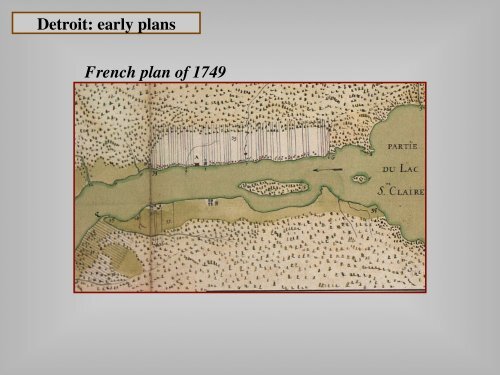Detroit early plans French plan of 1749
French plan of 1749 Detroit: early plans - TylerTopics.com
French plan of 1749 Detroit: early plans - TylerTopics.com
- No tags were found...
You also want an ePaper? Increase the reach of your titles
YUMPU automatically turns print PDFs into web optimized ePapers that Google loves.
<strong>Detroit</strong>: <strong>early</strong> <strong><strong>plan</strong>s</strong> <br />
<strong>French</strong> <strong>plan</strong> <strong>of</strong> <strong>1749</strong>
Fort <strong>Detroit</strong>, <strong>1749</strong>
<strong>Detroit</strong>: <strong>early</strong> <strong><strong>plan</strong>s</strong> <br />
British <strong>plan</strong> <strong>of</strong> 1763
Fort Wayne, 1840
<strong>Detroit</strong>: <strong>early</strong> <strong><strong>plan</strong>s</strong> <br />
<strong>Detroit</strong> plat map <strong>of</strong> 1825
Judge Woodward<br />
and his <strong>plan</strong>, 1825 <br />
Judge Augustus B. Woodward
Judge Woodward <strong>plan</strong> <br />
Based on L’Enfant’s <strong>plan</strong> <br />
Multi-radial grid <br />
Hierarchy <strong>of</strong> streets <br />
Many open spaces and plazas <br />
Focal points and landmark buildings
Old <strong>Detroit</strong> sketch <br />
A period when<br />
<strong>Detroit</strong> was<br />
considered the<br />
most beautiful<br />
city in the<br />
country.
Woodward and Monroe,<br />
1917
Ford Rouge Plant
<strong>Detroit</strong> freeway system <br />
A city <strong>of</strong> freeways...
Northland Mall, 1954
Reasons for <strong>Detroit</strong>’s decline <br />
1. Capital moved to the suburbs <br />
manufacturing moved to cheaper land <br />
residents followed <br />
services followed <br />
Led to 2 <strong>Detroit</strong>s <br />
2. Capital moved to the sunbelt <br />
<strong>Detroit</strong>’s factories were old <br />
Unions <br />
Labor laws <br />
Tax rates <br />
Political support in south <br />
Lower energy costs <br />
Fewer pollution regulations <br />
3. Reorganization and decentralization <strong>of</strong> auto industry on a global scale <br />
Development <strong>of</strong> “world car” <br />
Transportation/ communication revolution <br />
Inexpensive labor
Charles Blessing, Planner <br />
Planning and architecture degrees from MIT <br />
Regional <strong>plan</strong>ning director for Greater Boston <br />
Head <strong>plan</strong>ner for Chicago’s master <strong>plan</strong> <br />
“A <strong>plan</strong>ners’ <strong>plan</strong>ner” <br />
Traditional <strong>plan</strong>ner in Urban Renewal tradition <br />
Brought in a young, bright staff trained in urban design <br />
1956: Published <strong>Detroit</strong>’s “City <strong>of</strong> Tomorrow” <br />
Goal to reconstruct 30 sq. miles <strong>of</strong> inner city <br />
Promised <strong>Detroit</strong> would “lead the way in city design and <strong>plan</strong>ning” <br />
“We have to be concerned with architectural form from the outset.” <br />
His goal was to restore the city’s former glory.
Charles Blessing, Planner <br />
His <strong>plan</strong> failed… <br />
Urban renewal approach emphasized funding for demolition <br />
Lack <strong>of</strong> marketing skills by <strong>plan</strong>ning department <br />
they were designers <br />
Too many years <strong>of</strong> no development drove down land values <br />
Lack <strong>of</strong> public and political support <br />
Didn’t respect growing influence <strong>of</strong> African-American population <br />
Led to a second Planning Department under control <strong>of</strong> mayor <br />
<strong>Detroit</strong> still has two <strong>plan</strong>ning departments.
<strong>Detroit</strong> riots <br />
31 people had<br />
been killed.<br />
4,700<br />
paratroopers<br />
and 3,000<br />
National<br />
Guardsmen<br />
restored order.<br />
“The East Side<br />
is secure,” said<br />
Lieutenant<br />
General John<br />
Throckmorton,<br />
“and the West<br />
Side is under<br />
control but not<br />
quite secure.”
Racial clashes <br />
Racial conflicts as <strong>early</strong> as 1863 <br />
1925: Ku Klux Klan cross-burning attracted 10,000 people <br />
1943: Whites walked <strong>of</strong>f jobs when three blacks were hired <br />
1950s: Dearborn’s mayor : “Housing the Negroes is <strong>Detroit</strong>’s problem. Our city will<br />
remain lily white.” <br />
1967: <strong>Detroit</strong> riots <br />
43 people dead <br />
Whites moved to the suburbs <br />
White pop. 1960: 1,200,000; 1970: 800,000; Today: 200,000 <br />
1973: Coleman Young elected mayor <br />
In <strong>of</strong>fice for 20 years; he made it a black city. <br />
Black self-determination and black pride <br />
1977: Ren Cen built, but as a fortress
After the riots <br />
Michigan Central Train Station
<strong>Detroit</strong> demolition
<strong>Detroit</strong> demolition
<strong>Detroit</strong> ruins
An American Acropolis
AfricanTown
Paired Town Proposal
Paired Town Proposal <br />
“Pairing is the only alternative to a Black City<br />
Core and a White Ring or a White Out-town<br />
Newtown and a Black Newtown In-town.”
The new <strong>Detroit</strong> <br />
The Renaissance Center <br />
Show Robert A.M. Stern <br />
video on Ren Cen
People Mover
<strong>Detroit</strong> People-Mover <br />
An attempt to<br />
make the center<br />
city more<br />
desirable and<br />
more accessible.<br />
It was too limited<br />
in scope to fulfill<br />
its mission.
Empowerment Zones <br />
A program developed under the Clinton<br />
Administration, under which <strong>Detroit</strong> would receive<br />
$100 million and special tax benefits over a 10-year<br />
period. The program allows communities to<br />
determine their own needs, priorities and solutions. <br />
In <strong>Detroit</strong>, the project focused on three goals: <br />
- Creating economic opportunity <br />
- Sustaining competent, healthy and safe families <br />
- Restoring and upgrading neighborhoods
Brush Park,<br />
New housing
Addison Apartments
Campus Martius
Comerica and Ford Fields
MGM Grand and<br />
Greektown Casinos
Westin Book-Cadillac
Belle Isle
Belle Isle
Lafayette Park <br />
Mies:<br />
“The city is an entity subject to a principle <strong>of</strong> order,<br />
without which it can’t exist.”<br />
“Order is the disposition <strong>of</strong> equal and unequal things,<br />
attributing to each its place.”<br />
Mies viewed everyday life as chaos.<br />
“With order, the chaos in which we live would give way and<br />
the world would again become meaningful and beautiful.”
Lafayette Park <br />
Final site <strong>plan</strong>, 1956<br />
Ludwig Hilberseimer and<br />
Mies Van Der Rohe
Lafayette Park <br />
Modern architecture in a<br />
natural setting–<br />
In the middle <strong>of</strong> <strong>Detroit</strong>.
Lafayette Park <br />
It’s success is built not around the city,<br />
But around the “absence <strong>of</strong> city” in the <strong>plan</strong>.
Metro Airport <br />
Delta Airlines terminal
Metro Airport
Aerotropolis corridor
Gallagher book
Urban agriculture








